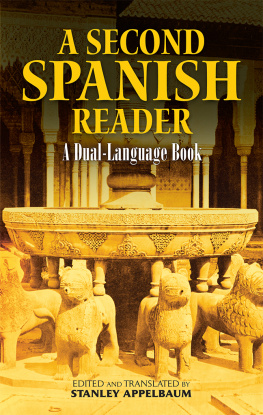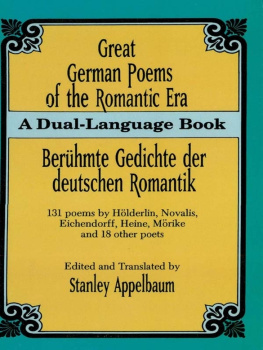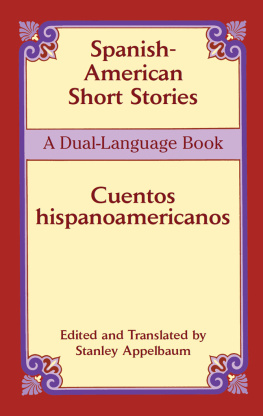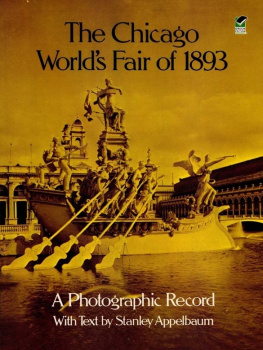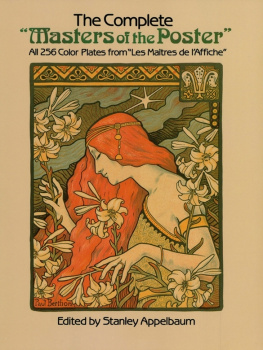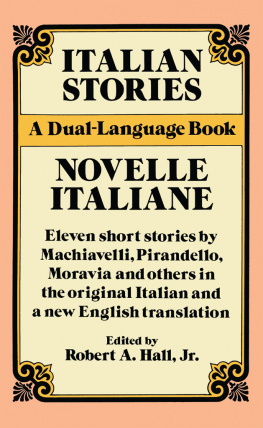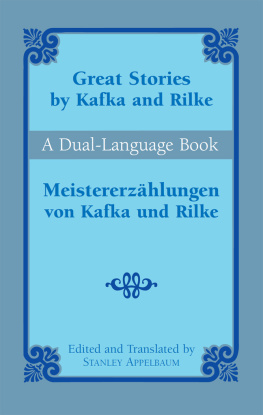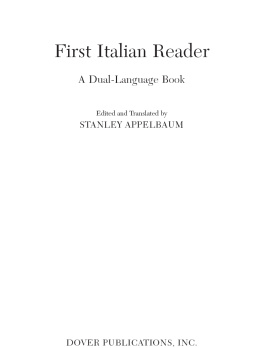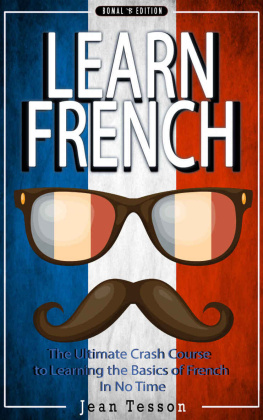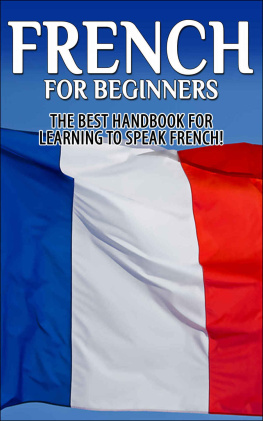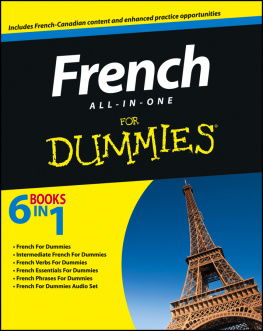Great
French Tales
of Fantasy
Contes
fantastiques
clbres
A Dual-Language Book
Edited and Translated by
STANLEY APPELBAUM
DOVER PUBLICATIONS, INC.
Mineola, New York
Copyright
Selection, English translations, Introduction, and footnotes copyright 2006 by Dover Publications, Inc.
All rights reserved.
Bibliographical Note
This Dover edition, first published in 2006, contains the full French text of six stories originally published between 1822 and 1890(see the Introduction for specific data), together with new translations. Stanley Appelbaum conceived of the volume, made the selection, did the translations, and wrote the Introduction and footnotes.
Library of Congress Cataloging-in-Publication Data
Great French Tales of fantasy=Contes fantastiques clbres: a dual language book / edited and translated by Stanley Appelbaum.
p. cm.
Title: Contes fantastiques clbres.
English and French.
Contains the full French text of six stories originally published between 1822 and 1890.
eISBN 13: 978-0-486-12171-0
1. Short stories, FrenchTranslations into English. 2. Short stories, French. 3. French fiction19th century Translations into English. 4.3. French fiction19th century. I. Title: Contes fantastiques clbres. II. Appelbaum, Stanley.
PQ1278.G78 2005
843'.087660807dc22
2005054930
Manufactured in the United States by Courier Corporation
44713802
www.doverpublications.com
CONTENTS
Introduction
The nineteenth century is generally considered as the golden age of the French short story (conte, nouvelle, rcit,...), which had made fitful, though significant, progress since the medieval period, passing through such phases as the Boccaccio-inspired narratives of the sixteenth century and the philosophical parables of the eighteenth. During its great century, a place of honor was held by the conte fantastique, five of whose preeminent exponents are represented in this volume by highly regarded examples of the genre.
The inspiration for French fantasy tales of the Romantic period often came from the Arabian Nights (known in France since the early eighteenth century); from more recent native works, such as Cazottes Le diable amoureux; and, beginning in 1829, from the translated works of the German master E. T. A. Hoffmann (17761822). The Romantic-era stories included here are those by Nodier (some of whose best work precedes the Hoffmann craze), Gautier, and Mrime (the latter two continued to write fantasy even later).
After something of a gap in mid-century, during which the predominant Realist mode largely precluded fantasy, the genre resumes, sometimes with even greater narrative finesse and more intense psychological insights, in the work of the Symbolists, Decadents, and even some Naturalists. In this period Poe, whose stories had been brilliantly rendered by Baudelaire between 1852 and 1865, became a major model for authors. Villiers de lIsle-Adam and Maupassant are the spokesmen here for the latter part of the century. (The stories are arranged chronologically by date of first publication, not by date of authors birth.)
As is well known, the conte fantastique, glorified by the Surrealists and deftly handled by other twentieth-century French writers, has continued to be a significant and clearly recognized genre amid the gratifying diversity of French literature.
Charles Nodier
Nodier has been called ahead of his time, the most wonderful creator in the French Romantic era, and the true founder of French fantasy literature. Trilby is one of his major works, repeatedly singled out for discussion even in general literary reference books.
Life. Jean-Charles-Emmanuel Nodier, born in 1780 in Besanon (in the Jura mountains of eastern France, near Switzerland), was the illegitimate son of an eminent Jacobin criminal judge and a servant woman. Precocious, he delivered a public address at age eleven. During the Reign of Terror, he was horrified, and emotionally scarred for life, by the executions he witnessed in Besanon. After local schooling (he became an expert in entomology, and an assistant librarian at the school, and he was already attracted to secret societies), he lived in Paris off and on beginning in 1800. His first novel appeared in 1802. The following year, he was jailed for 36 days for having composed an ode attacking Napoleon. In 1808, he became a teacher in the Jura, and married, remaining chiefly in the provinces until 1813, when he was named as a government secretary and librarian in Laibach (now Ljubljana) in what was then the Napoleonic puppet state Illyria (basically Dalmatia, but including other parts of latter-day Yugoslavia); in Illyria he became fascinated by the local folklore, which was imbued with some of the most extreme beliefs to be found in Europe, such as that in vampirism.
After nine months at Laibach, Nodier returned to Paris, where he practiced journalism. In 1814, he welcomed the Bourbon Restoration under Louis XVIII. His long but intermittent career as a writer of fantasy (he wasnt always able to devote his full time to fiction) began in 1818. An extremely pleasurable trip to Scotland in 1821followed later that year by the publication of Promenade de Dieppe aux montagnes dcosse (Excursion from Dieppe to the Mountains of Scotland; this travel account included reminiscences of a strikingly pretty ferrywoman)was the inspiration for his 1822 story Trilby (see discussion below). In 1824, a turning point in his life, he became director of the prestigious Parisian library, the Bibliothque de lArsenal, which became his home, as well; there he presided for years over one of the most important literary salons, captaining the early Romantic movement and nurturing many young talents, including the dazzling genius Victor Hugo, who broke away in 1828 to conduct a circle of his own. The marriage in 1830 of Nodiers sole surviving daughter left him with severe neurasthenia.
Nodier continued to write contes fantastiques, the chief of which (also set in Scotland) is the lengthy 1832 La Fe aux Miettes (The Crumb Fairy); but he also wrote numerous learned philological and other nonfictional works, such as a critique of dictionaries of French. Beginning in 1820 he participated in the ongoing series of Voyages pittoresques et romantiques dans lancienne France (Picturesque and Romantic Travels in Old France), which made the Parisian public conscious of many neglected cultural treasures in the provinces that were crying out for conservation. In 1833 Nodier was elected a member of the Acadmie Franaise (when he died in 1844, his replacement was Mrime). His last conte fantastique appeared posthumously.
Trilby. This story was first published by Ladvocat, Paris, in 1822 as a separate small volume, with the title Trilby,/ou/le Lutin dArgail./ Nouvelle cossoise (Trilby; or, The Elf of Argyll. A Scottish Tale) and the motto Amour et charit (Love and Charity), which occurs in the story, representing a major theme. (See the Appendix to this volume for Nodiers two informative prefaces to the story.) Trilby can be taken at face value as a supernatural haunting, or it can be read, without unduly straining the interpretation, as a psychoanalytical study of repressed libido, with the minds censor refashioning the loved one in dreams into the semblance of a nonhuman figure familiar to the dreamer from everyday folklore, and with the monk Ronald embodying the dreamers own guilt complex. (Smarra is largely concerned with dreams and nightmares, and Nodier wrote an essay on that subject in 1831. Gnosticism and the occult also influenced his work.)
The dreamlike subject matter of Trilby is more suitable than that of other stories by Nodier to his discursive, amiable style (already somewhat old-fashioned at the time), characterized by long and intricate complex sentences. But this doesnt signify monotony: his prose is consciously musical; his descriptions of nature are incisive as well as charming; and several of Trilbys love speeches are glowingly ardent, the soul of Romanticism in any acceptation of the term. The story borrows a number of elements from earlier Gothic novels, such as the fanatical monk, the graveyard, the mysterious paintings, and the hidden family relationships; but, in turn, it adds a rather extensive ethnography of Scotland.
Next page

